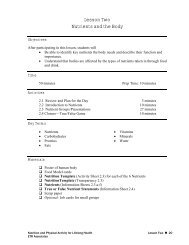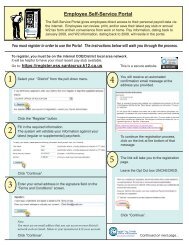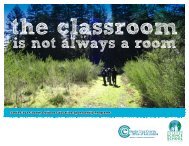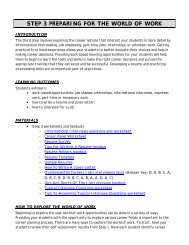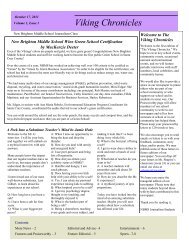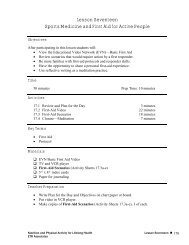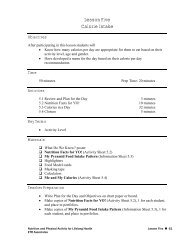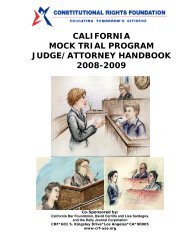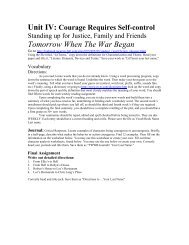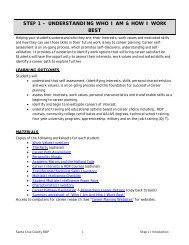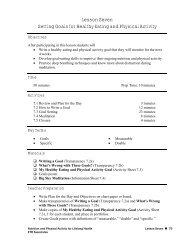Lesson 15 - Physical Education for Body, Mind and Spirit
Lesson 15 - Physical Education for Body, Mind and Spirit
Lesson 15 - Physical Education for Body, Mind and Spirit
You also want an ePaper? Increase the reach of your titles
YUMPU automatically turns print PDFs into web optimized ePapers that Google loves.
<strong>Lesson</strong> Fifteen<br />
Cardiorespiratory Health: Learning about Heart Rate Zones<br />
Objectives<br />
After participating in this lesson students will<br />
• Learn the five heart rate zones.<br />
• Underst<strong>and</strong> that the heart works harder at different intensity levels.<br />
• Practice taking their heart rate while exercising.<br />
• Track progress on their healthy eating <strong>and</strong> physical activity goals.<br />
Time<br />
Activities<br />
50 minutes Prep Time: 25 minutes<br />
<strong>15</strong>.1 Review <strong>and</strong> Plan <strong>for</strong> the Day 3 minutes<br />
<strong>15</strong>.2 Heart Rate Zones 5 minutes<br />
<strong>15</strong>.3 Finding Your Heart Rate 18 minutes<br />
<strong>15</strong>.4 Exercising in Heart Rate Zones 14 minutes<br />
<strong>15</strong>.5 Tracking Progress 5 minutes<br />
<strong>15</strong>.6 Closure 5 minutes<br />
Key Terms<br />
• Heart Rate<br />
• Resting Heart Rate<br />
• Heart Rate Zones<br />
• Aerobic<br />
• Anaerobic<br />
Materials<br />
Heart Rate Zones poster<br />
How to Take Your Heart Rate poster<br />
Heart Rate (Activity Sheet <strong>15</strong>.3)<br />
Calculators<br />
Resistance b<strong>and</strong>s<br />
Jump ropes<br />
Teacher Preparation<br />
• Write Plan <strong>for</strong> the Day <strong>and</strong> Objectives on chart paper or board.<br />
• Make Heart Rate Zones poster. (See Activity <strong>15</strong>.2.)<br />
• Make How to Take Your Heart Rate poster. (See Activity <strong>15</strong>.3.)<br />
• Make transparency (1) <strong>and</strong> copies of Heart Rate (Activity Sheet <strong>15</strong>.3), 1 <strong>for</strong> each<br />
student, <strong>and</strong> place in portfolios.<br />
Nutrition <strong>and</strong> <strong>Physical</strong> Activity <strong>for</strong> Lifelong Fitness <strong>Lesson</strong> Fifteen • 149<br />
ETR Associates
<strong>15</strong>.1 Review <strong>and</strong> Plan <strong>for</strong> the Day 3 minutes<br />
Materials: Plan <strong>for</strong> the Day <strong>and</strong> Objectives<br />
Write the Plan <strong>for</strong> the Day <strong>and</strong> Objectives on the board be<strong>for</strong>e class, listing all of the<br />
activities students will be doing.<br />
Plan <strong>for</strong> the Day:<br />
• Heart Rate Zones<br />
• Finding Your Heart Rate<br />
• Exercising in Heart Rate Zones<br />
• Tracking Progress<br />
Review the previous class. Ask students to name a way that they were aware of body image<br />
since the last class.<br />
Explain that today they will be learning about the different heart rate zones that their heart<br />
works at when exercising at different intensities. Explain that they will learn how to take<br />
their heart rate while they are exercising. They will also be looking at their progress on their<br />
healthy eating <strong>and</strong> physical activity goals.<br />
Review the Objectives with students.<br />
<strong>15</strong>.2 Heart Rate Zones 5 minutes<br />
Materials: Poster of the 5 Heart Rate Zones<br />
Tell students that today’s lesson is focused on heart rate zones (each zone accesses a<br />
different intensity level), which has to do mostly with the cardiorespiratory component of<br />
fitness. Ask them if they remember the 4 components of fitness, including cardiorespiratory.<br />
Direct their attention to the Key Terms chart to help them if they don’t remember.<br />
Acknowledge that when working in different zones they are also having an effect on the<br />
other three fitness components (muscular strength, muscular endurance <strong>and</strong> flexibility). We<br />
are always using the cardiorespiratory system at some level as long as we are alive <strong>and</strong><br />
breathing.<br />
Show the poster of the 5 Heart Rate Zones. Explain that these 5 zones represent a percentage<br />
of your maximum heart rate. They require progressively more exertion.<br />
1. Weight Management Zone (40-50% of max. heart rate)<br />
2. Healthy Heart Zone (50-70% of max. heart rate)<br />
3. Aerobic (muscle working with oxygen) Zone (70-85% of max. heart rate)<br />
4. Anaerobic (muscle working without oxygen) Zone (80-95% of max heart<br />
rate)<br />
5. Red Zone (90-100% of max. heart rate)<br />
Nutrition <strong>and</strong> <strong>Physical</strong> Activity <strong>for</strong> Lifelong Fitness <strong>Lesson</strong> Fifteen • <strong>15</strong>0<br />
ETR Associates
<strong>15</strong>.3 Finding Your Heart Rate 18 minutes<br />
Materials: How to Take Your Heart Rate poster, pencils, calculators, Heart Rate (Activity<br />
Sheet <strong>15</strong>.3)<br />
Explain that students will be working on finding their heart rate (the number of heart beats<br />
per unit of time, usually expressed as beats per minute) in the different zones. There<strong>for</strong>e, the<br />
first thing they are going to do is take their heart rate. This heart rate will be considered a<br />
resting heart rate (the heart rate when a person is resting).<br />
• Teach students how to take their heart rate by following the steps on the How to Find<br />
Your Heart Rate poster. (Write the following instructions on a piece of chart paper<br />
be<strong>for</strong>e class.)<br />
o Press your first two fingertips lightly against the side of your neck, just below the<br />
jawbone, halfway between your ear <strong>and</strong> your chin, until you feel a strong beat.<br />
o Count the number of beats <strong>for</strong> 1 minute.<br />
• Have students write the number they get on the Heart Rate activity sheet on line 2,<br />
Resting Heart Rate (RHR).<br />
Now that students know how to take their heart rate, direct their attention to the instructions<br />
on the Heart Rate activity sheet. Explain that they will be finding their heart rate <strong>for</strong> the<br />
different zones. Students can find their target heart rate range by doing the calculations on<br />
the activity sheet.<br />
• Have students begin filling out the activity sheet by calculating their Heart Rate<br />
Reserve. (See Karvonen Method below <strong>for</strong> directions.) Give each student a calculator<br />
in order to do the calculations. Walk them through the steps of finding this<br />
calculation, checking their work to ensure that they do it correctly. Show a<br />
transparency of the Heart Rate activity sheet so you can work along with the<br />
students. When working through the activity sheet as an example use the age that is<br />
most prevalent in the class.<br />
The basic calculation <strong>for</strong> Heart Rate Reserve is called the Karvonen Method:<br />
1. Subtract age from 220. (220 – <strong>15</strong> = 205)<br />
2. Measure resting heart rate. (70)<br />
3. Subtract resting heart rate from the maximum heart rate. (205 – 70 = 135)<br />
• This completes the first section of the activity sheet. The students now have their<br />
heart rate reserve <strong>and</strong> their resting heart rate. Once students have this calculation,<br />
they can go on to calculate their heart rate in the different zones. Direct students to<br />
the boxes on the activity sheet that say Weight Management Zone, Healthy Heart<br />
Zone <strong>and</strong> Aerobic Zone. Tell them they can go ahead <strong>and</strong> fill in the numbers <strong>for</strong> the<br />
Heart Rate Reserve (HRR) <strong>and</strong> their resting heart rate (RHR).<br />
Nutrition <strong>and</strong> <strong>Physical</strong> Activity <strong>for</strong> Lifelong Fitness <strong>Lesson</strong> Fifteen • <strong>15</strong>1<br />
ETR Associates
• They will now do some more calculations using these numbers to find their heart rate<br />
<strong>for</strong> these different zones. Go through steps 4 through 6 to complete the activity sheet.<br />
Again, walk students through the first equation, ensuring they are putting the correct<br />
numbers in the appropriate place.<br />
4. Multiply the number from step 3 by the intensity percentage desired. (.75 x<br />
135 = 81.25)<br />
5. Add the resting heart rate to the number calculated in step 4. (70 + 81 = <strong>15</strong>1)<br />
6. The target heart rate <strong>for</strong> a <strong>15</strong> year old person to achieve 75% of their<br />
maximum heart rate would be <strong>15</strong>1 beats per minute.<br />
Explain to students that they will now be participating in some exercises that will get their<br />
heart rate into some of these zones, depending on how hard they are working <strong>and</strong> maintaining<br />
their heart rate.<br />
<strong>15</strong>.4 Exercising in Heart Rate Zones 14 minutes<br />
Materials: Heart Rate (Activity Sheet <strong>15</strong>.3), pencils, resistance b<strong>and</strong>s, jump ropes<br />
Explain that students will be doing some exercises now in order to bring their heart rate into<br />
some of the different heart rate zones.<br />
• As a class they will be participating together in the activities. Explain that they are to<br />
use the heart rate finding method they learned earlier in class to keep track of their<br />
heart rate throughout the activities.<br />
• Students will be writing down their heart rates on the activity sheet on the lines that<br />
say Stretching, Resistance B<strong>and</strong>s, Jumping Rope <strong>and</strong> Cool Down. (The cool-down<br />
can be any kind of activity that will gradually slow the heart—slow walking,<br />
stretching, etc.)<br />
• Have students st<strong>and</strong> in a circle <strong>and</strong> lead them in some stretches. Make sure the<br />
students have their activity sheets <strong>and</strong> a pencil. You can have the students lead the<br />
class in stretches or do it yourself.<br />
• After a few stretches, have students take their heart rate <strong>for</strong> 1 minute. Then have<br />
them record their heart rate on the Stretching line on the activity sheet.<br />
• Give each student a resistance b<strong>and</strong>. Do bicep curls with the students. Do 3 sets of<br />
10 repetitions. Have them record their heart rate on the Resistance B<strong>and</strong> line.<br />
• Next have students jump rope <strong>for</strong> about 1 minute continuously. Have them record<br />
their heart rate on the Jumping Rope line.<br />
• At the end of the exercise, have students cool down by walking or doing some<br />
stretches. Have them record their heart rate on the Cool Down line.<br />
Nutrition <strong>and</strong> <strong>Physical</strong> Activity <strong>for</strong> Lifelong Fitness <strong>Lesson</strong> Fifteen • <strong>15</strong>2<br />
ETR Associates
<strong>15</strong>.5 Tracking Progress 5 minutes<br />
Materials: Tracking My Progress (Activity Sheet <strong>15</strong>.5)<br />
Remind students of the goals that they wrote <strong>for</strong> themselves. Remind them that once a week<br />
the whole class has been looking at how they did on achieving their goals.<br />
• Refer students to the Tracking My Progress activity sheet in their portfolios. Have<br />
them write in their goals <strong>for</strong> both healthy eating <strong>and</strong> physical activity.<br />
• Then have them fill out the rest of the sheet, choosing one of their goals to focus on.<br />
Ask students to share with a partner how they did on their goal this past week. What were<br />
the challenges What did they do to meet their goal How did they feel about working<br />
toward their goal<br />
<strong>15</strong>.6 Closure 5 minutes<br />
Ask students what each exercise activity felt like. Relate their answers to the in<strong>for</strong>mation on<br />
the Heart Rate Zones poster, making the point that as the heart works harder so does the rest<br />
of the body. Ultimately, students will feel the effects of the different zones as they increase in<br />
cardio-vascular intensity.<br />
Have students choose one of the heart rate zones that they will commit to working out in <strong>for</strong><br />
a half hour in the coming week. Have them each tell a classmate what activity they will do to<br />
achieve this.<br />
Resources<br />
The Fitness <strong>Education</strong> Pyramid, 2 nd ed. by Donna Terbizan, Brad<strong>for</strong>d Str<strong>and</strong>, Karen Roesler,<br />
Lois Mauch <strong>and</strong> Janelle Schumacher. Copyright 2001, F. E. P. Sales <strong>and</strong> Consulting. PO<br />
Box 201, West Fargo, ND.<br />
Activity <strong>15</strong>.3 Finding Your Heart Rate: collaboration with All 4 You 2! curriculum <strong>Lesson</strong> 9,<br />
Activity 4.<br />
Nutrition <strong>and</strong> <strong>Physical</strong> Activity <strong>for</strong> Lifelong Fitness <strong>Lesson</strong> Fifteen • <strong>15</strong>3<br />
ETR Associates
Heart Rate<br />
Activity Sheet <strong>15</strong>.3<br />
Finding Your Target Heart Rate Zone<br />
To calculate your Target Heart Rate Zone, use the following <strong>for</strong>mula:<br />
1. 220 - (your age) = Max Heart Rate (MHR)<br />
2. Measure your resting heart rate (RHR).<br />
3. MHR - RHR (resting heart rate) = Heart Rate Reserve (HRR)—The difference<br />
between your resting <strong>and</strong> maximum heart rates.<br />
4. HRR x % of intensity = Training Range %<br />
5. Training Range % + RHR = Target Heart Rate<br />
Let’s break the <strong>for</strong>mula apart. First, find your Maximum Heart Rate <strong>and</strong> your Resting<br />
Heart Rate:<br />
1. 220 - ____ = ____<br />
AGE Max. Heart Rate (MHR)<br />
2. Resting Heart Rate(RHR) ____<br />
3. ____ - ____ = ____<br />
MHR RHR Heart Rate Reserve (HRR)<br />
Now that you have your Maximum Heart Rate <strong>and</strong> your Heart Rate Reserve you can<br />
calculate your Heart Rate <strong>for</strong> the following zones.<br />
Weight Management Zone<br />
40% of Target Heart Rate Zone<br />
___ x .40 = ______<br />
HRR Training Range 45% (TR %)<br />
_____ + ____ = _______<br />
TR% RHR HR at low end of Weight Management Zone<br />
50% of Target Heart Rate Zone<br />
____ x .50 = ______<br />
HRR Training Range 50% (TR %)<br />
_____ + ____ = ______<br />
TR% RHR HR at high end of Weight Management Zone<br />
Nutrition <strong>and</strong> <strong>Physical</strong> Activity <strong>for</strong> Lifelong Fitness <strong>Lesson</strong> Fifteen • <strong>15</strong>4<br />
ETR Associates
Heart Rate (continued)<br />
Activity Sheet <strong>15</strong>.3<br />
Healthy Heart Zone<br />
50% of Target Heart Rate Zone<br />
_____<br />
HR at low end of Healthy Heart Zone<br />
70% of Target Heart Rate Zone<br />
____ x .70 = ______<br />
HRR Training Range 70% (TR %)<br />
_____ + ____ = ______<br />
TR% RHR HR at high end of Healthy Heart Zone<br />
Aerobic Zone<br />
70% of Target Heart Rate Zone<br />
_____<br />
HR at low end of Aerobic Zone<br />
85% of Target Heart Rate Zone<br />
____ x .85 = ______<br />
HRR Training Range 85% (TR %)<br />
_____ + ____ = ______<br />
TR% RHR HR at high end of Aerobic Zone<br />
1. Stretching________________<br />
2. Resistance B<strong>and</strong>s__________<br />
3. Jumping Rope_____________<br />
4. Cool Down________________<br />
Nutrition <strong>and</strong> <strong>Physical</strong> Activity <strong>for</strong> Lifelong Fitness <strong>Lesson</strong> Fifteen • <strong>15</strong>5<br />
ETR Associates
Activity Sheet <strong>15</strong>.5<br />
My healthy eating goal:<br />
My physical activity goal:<br />
Date: __________<br />
What I did to meet my goal:<br />
‣ _________________________________________________________<br />
‣ _________________________________________________________<br />
‣ _________________________________________________________<br />
‣ _________________________________________________________<br />
‣ _________________________________________________________<br />
What I learned this week:<br />
Benefits I enjoyed this week: _____________________________________________<br />
_____________________________________________________________________<br />
Challenges I had: ______________________________________________________<br />
____________________________________________________________________<br />
Possible ways to deal with challenges if they come up again: ____________________<br />
_____________________________________________________________________<br />
What am I going to do toward my goal next week: ____________________________<br />
____________________________________________________________________<br />
Who could help me with my goal if I need support: ____________________________<br />
Adapted with permission from Health Smart High School.<br />
Nutrition <strong>and</strong> <strong>Physical</strong> Activity <strong>for</strong> Lifelong Fitness <strong>Lesson</strong> Fifteen • <strong>15</strong>6<br />
ETR Associates



